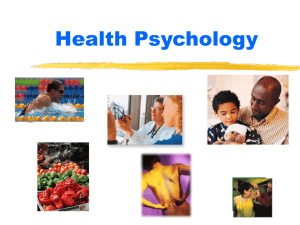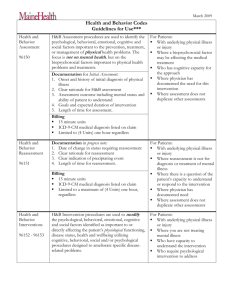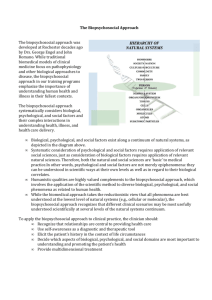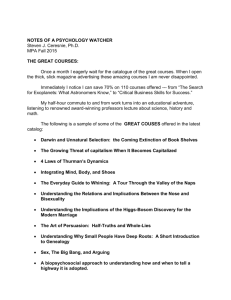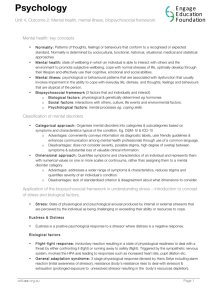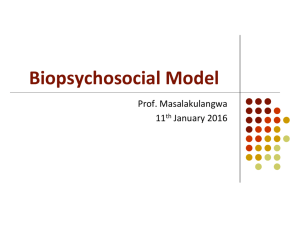Biological and Biopsychosocial Models of Health and Disease in
advertisement
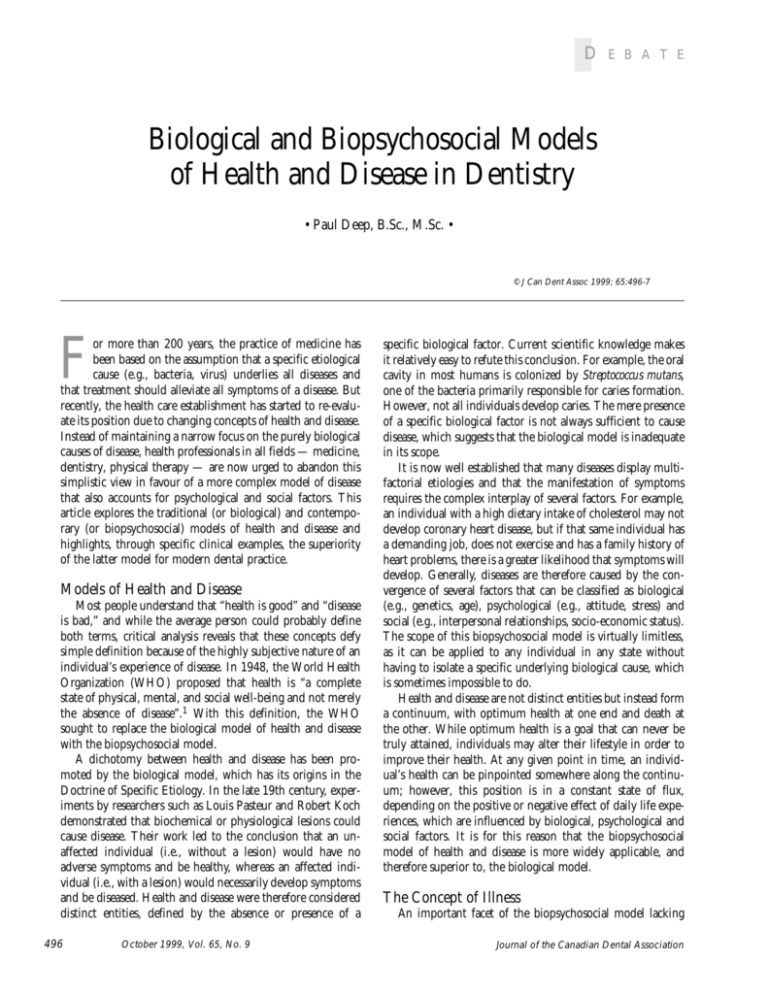
D E B A T E Biological and Biopsychosocial Models of Health and Disease in Dentistry • Paul Deep, B.Sc., M.Sc. • © J Can Dent Assoc 1999; 65:496-7 F or more than 200 years, the practice of medicine has been based on the assumption that a specific etiological cause (e.g., bacteria, virus) underlies all diseases and that treatment should alleviate all symptoms of a disease. But recently, the health care establishment has started to re-evaluate its position due to changing concepts of health and disease. Instead of maintaining a narrow focus on the purely biological causes of disease, health professionals in all fields — medicine, dentistry, physical therapy — are now urged to abandon this simplistic view in favour of a more complex model of disease that also accounts for psychological and social factors. This article explores the traditional (or biological) and contemporary (or biopsychosocial) models of health and disease and highlights, through specific clinical examples, the superiority of the latter model for modern dental practice. Models of Health and Disease Most people understand that “health is good” and “disease is bad,” and while the average person could probably define both terms, critical analysis reveals that these concepts defy simple definition because of the highly subjective nature of an individual’s experience of disease. In 1948, the World Health Organization (WHO) proposed that health is “a complete state of physical, mental, and social well-being and not merely the absence of disease”.1 With this definition, the WHO sought to replace the biological model of health and disease with the biopsychosocial model. A dichotomy between health and disease has been promoted by the biological model, which has its origins in the Doctrine of Specific Etiology. In the late 19th century, experiments by researchers such as Louis Pasteur and Robert Koch demonstrated that biochemical or physiological lesions could cause disease. Their work led to the conclusion that an unaffected individual (i.e., without a lesion) would have no adverse symptoms and be healthy, whereas an affected individual (i.e., with a lesion) would necessarily develop symptoms and be diseased. Health and disease were therefore considered distinct entities, defined by the absence or presence of a 496 October 1999, Vol. 65, No. 9 specific biological factor. Current scientific knowledge makes it relatively easy to refute this conclusion. For example, the oral cavity in most humans is colonized by Streptococcus mutans, one of the bacteria primarily responsible for caries formation. However, not all individuals develop caries. The mere presence of a specific biological factor is not always sufficient to cause disease, which suggests that the biological model is inadequate in its scope. It is now well established that many diseases display multifactorial etiologies and that the manifestation of symptoms requires the complex interplay of several factors. For example, an individual with a high dietary intake of cholesterol may not develop coronary heart disease, but if that same individual has a demanding job, does not exercise and has a family history of heart problems, there is a greater likelihood that symptoms will develop. Generally, diseases are therefore caused by the convergence of several factors that can be classified as biological (e.g., genetics, age), psychological (e.g., attitude, stress) and social (e.g., interpersonal relationships, socio-economic status). The scope of this biopsychosocial model is virtually limitless, as it can be applied to any individual in any state without having to isolate a specific underlying biological cause, which is sometimes impossible to do. Health and disease are not distinct entities but instead form a continuum, with optimum health at one end and death at the other. While optimum health is a goal that can never be truly attained, individuals may alter their lifestyle in order to improve their health. At any given point in time, an individual’s health can be pinpointed somewhere along the continuum; however, this position is in a constant state of flux, depending on the positive or negative effect of daily life experiences, which are influenced by biological, psychological and social factors. It is for this reason that the biopsychosocial model of health and disease is more widely applicable, and therefore superior to, the biological model. The Concept of Illness An important facet of the biopsychosocial model lacking Journal of the Canadian Dental Association Biological and Biopsychosocial Models of Health and Disease in Dentistry from the biological model is the concept of illness, which refers to a person’s individual experience of disease.2 Illness is a subjective measure of disease, in contrast to strictly objective indices such as body temperature or cholesterol level. The development of an illness is not limited to a biological disequilibrium; psychological and social factors can influence a patient’s reaction to his or her condition. The concept of illness, therefore, reflects more accurately the complexities of the biopsychosocial model of health and disease. The concept of illness blurs the rigid distinction between health (good) and disease (bad) established by the biological model. For example, consider two individuals, each with a deep carious lesion. Patient A is relatively unaffected by the cavity: he tolerates the pain well, such that his psychological state is unaltered, and continues to socialize. Patient B is bothered by the cavity: he is preoccupied with the pain, such that his general attitude has deteriorated, and does not socialize. While both individuals have the same underlying biological problem, they experience it differently as a result of psychological and social factors. Patient A considers himself healthy, while patient B considers himself unhealthy (or diseased). Their individual subjective experiences determine the extent of their illness and the impact it has on their quality of life. Comparing the Models The practical benefits of applying the biopsychosocial model of health and disease to modern dental treatment can best be illustrated with a clinical example. Consider a patient with adult chronic periodontitis who does not floss. A dentist following the biological model may suggest that the patient floss every day to remove the bacteria implicated in the etiology of periodontitis. A dentist following the biopsychosocial model may make the same suggestion, but will also delve further into the patient’s history, asking why the patient doesn’t floss (“I have arthritis in my hands”), why the patient chose to seek treatment now (“It hurts”), how the periodontitis makes the patient feel (“I can’t take it anymore”), what the patient eats, and what sort of home oral care, if any, the patient practises. In the first case, the dentist assumes a specific underlying biological cause and recommends a treatment aimed at Journal of the Canadian Dental Association eliminating that cause. In the second case, the dentist may uncover more general psychological and social factors contributing to, or stemming from, the periodontitis. The dentist can then tailor a treatment plan specifically geared to the patient’s individual needs, thereby increasing the likelihood of compliance. A treatment plan is only effective if the patient follows it; simply telling someone to floss more, without knowing why that person doesn’t, is not likely to lead to positive change. Conclusion The biological model of health and disease is outdated and inadequate. Health and disease can no longer be considered distinct entities where one exists only in the absence of the other. A physiological condition that prompts one person to seek medical or dental treatment may be perfectly acceptable to another person. Therefore, despite the importance of biological phenomena with respect to the etiology of diseases, thorough evaluation of a disease cannot be based solely on biological factors. Indeed, psychological and social factors must also be considered, such that the question of what is healthy and what is not becomes very subjective, and is more properly explained by the concept of illness. Whereas the biological model restricts itself to searching for a specific underlying cause of disease, the biopsychosocial model explores all aspects of an illness, and is thus a more valuable diagnostic tool for the modern dental practitioner. Acknowledgments: The author would like to thank Dr. Paul Allison, assistant professor in the faculty of dentistry at McGill University, for his valuable insights. Mr. Deep is a third-year student enrolled in the DMD program at the faculty of dentistry, McGill University. The views expressed are those of the author and do not necessarily reflect the opinion and official policies of the Canadian Dental Association. References 1. WHO. International classification of impairments, disabilities and handicaps. Geneva: World Health Organization; 1980. 2. Mechanic D. Medical sociology. New York: Free Press; 1968. October 1999, Vol. 65, No. 9 497
